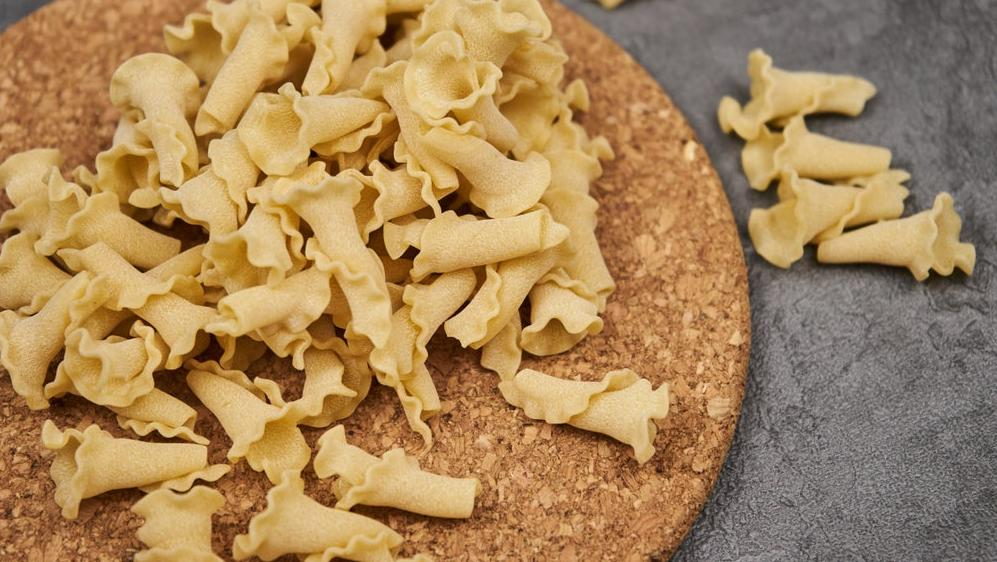The Most Underrated Pasta Shapes For Mac And Cheese
Swap out elbow macaroni and try one of these pastas in your next batch.
Whenever I make a pot of creamy stovetop mac and cheese in my dutch oven at home, I seize the opportunity to use up some pasta from my cupboard—and folks, my cupboard has a lot of pasta to be blown out. That's because whenever I leave an Italian deli or grocery, I end up walking out the door with something fun and obscure. Vesuvio, racchette, farfalline, malloreddus, lumache, creste de gallo—often hyper-regional, these specific and peculiar shapes excite my curiosity. And many of them turn a pot of mac and cheese into something truly great.
There are loud macaroni traditionalists out there, those who strictly champion the use of elbow macaroni, and maybe cavatappi if they're feeling adventurous. We're told to use cylindrical, tube-like pastas for mac and cheese due to the noodles' surface area and "forkability." But because this dish consists of cheese and carbs, it's almost impossible to make a bad batch, as long as you know how to conjure a good sauce. And after lots of experimentation, I've found that some pasta shapes improve the overall experience tremendously.
Though the noodles are aesthetically pleasing, I'm not keen on the farcical nature of wacky cavatappi. I like cups. Orecchiette. Cavatelli. Pasta shapes that hold sauce and become a neat little vessel for creamy, molten cheese. Ridges are a bonus. And yes—you can use long pasta to make a mac and cheese, though you probably have to change the cooking method to make it work (more on that later). Point is, anything can work in a mac.
The newly invented and allegedly optimized cascatelli claims to have revolutionized pasta by introducing a more functional shape, but plenty of Italians will tell you mafaldine has been around for much longer. Also, have you seen the aforementioned creste de gallo? Plenty of underrated, preexisting pasta shapes are great for mac and cheese, and you should try making a batch that swaps these in for elbow macaroni. And if I can't sell you on that, hey, let's just celebrate these cool-ass shapes.
De Cecco Gnocchi No. 46
No, these gnocchi aren't the soft little potato pillows you're probably imagining. Gnocchi No. 46 are made from semolina dough and simply inspired from potato gnocchi. Though they have a somewhat similar shape to gnocchi, these are strikingly concave, ribbed, and great for capturing melty, cheesy sauce. They're also quite substantial, so you'll likely find yourself eating them one or two at a time instead of a heaping spoonful of tiny elbows.
Everyone I've talked to about Gnocchi No. 46 has been thrown off by seeing the word "gnocchi" on a box of semolina pasta, but this shape seems to be an ode to the gnocchi of old, which was made without potatoes. Semolina came before potatoes in the art of pasta making, and these are a throwback (way back) to those days. By the way, most of that store-bought gnocchi sold on the shelf? It's bad. I'd much rather eat this.
Spaghetti
I used to work at a New Orleans–centric seafood restaurant in Austin, Texas that made big hotel pans full of mac and cheese mixed with spaghetti. These trays got baked, then cut into squares and microwaved at the last second for customers. The result was always a thick, casserole-like mac that I like to call Caucasian pastitsio. Customers loved it.
Now, I'm not sure about using spaghetti for a straight-up stovetop mac and cheese—at that point, maybe you should just make cacio e pepe?—but the hotel pan casserole-style baked mac with spaghetti is new and exciting. The long noodles end up permeating the mac mixture in a way that other pastas just can't, and using only short pasta in a baked mac just doesn't work as well. Spaghetti snakes its way through the cheese and béchamel sauce fluidly.
Orecchiette
You know it, you love it, and it might even be your favorite pasta shape (it's definitely mine). Orecchiette is a cup-shaped pasta that works well with mac and cheese due to its ridges and awesome concave shape. Store-bought orecchiette is just fine, with a big-but-not-too-big shape that inserts flawlessly into your cheese béchamel. That said, if you ever want to make the stuff yourself, you'll unlock a whole new tier of delightful chewiness with fresh orecchiette dough. Sure, using handmade pasta in mac and cheese might seem like an excessive amount of work, but if you're into deeply sensual food experiences you have to try it.
Cavatelli
Cavatelli are similar in shape to gnocchi but smaller and thinner. It's a short pasta so it holds sauce well, but you can also snare three or four of 'em on your fork at a time. Often referred to the "gnocchi of the south," cavatelli started out as a semolina pasta centuries ago but eventually evolved into a pasta made with potato and and even ricotta, the latter of which I grew up with. Can you imagine eating some soft, cheesy cavatelli served in a molten cheese sauce? This is the shit I put on my vision board.
Campanelle
Campanelle means "bellflowers" or "little bells" in Italian, but when I look at 'em I see chanterelle mushrooms. The tip of this botanical-shaped pasta blossoms and spirals into a sort of ridged flower bud, a deep-cut pasta shape that isn't seen very often. Campanelle is filled with little nooks and crannies, so sauce will get stuck in there effortlessly. If you insist on using words like "forkability," then yes, campanelle is easy to stab with your pronged utensil. It's also just great to look at. All the practicality with the added bonus of aesthetic pleasure. Elbow macaroni just can't compete.
